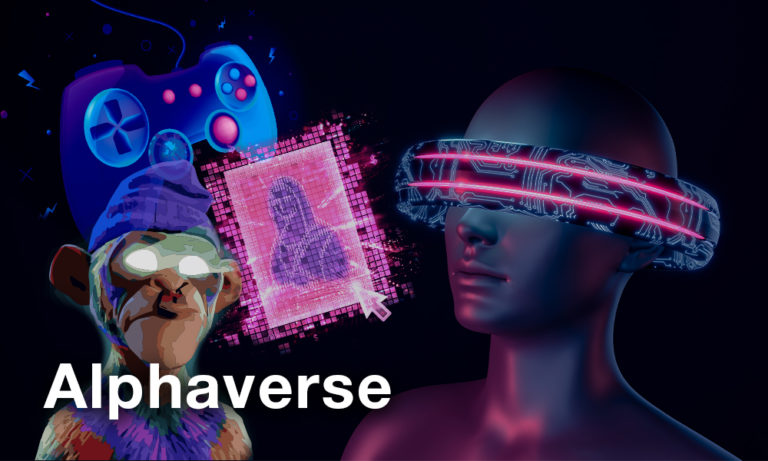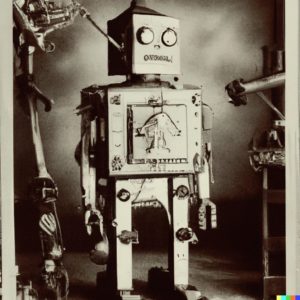Blurring the lines between human and machine

If you’ve ever watched an episode of Black Mirror, you’ll be familiar with its transhuman vision of the near future. The series presents a world where the lines between the human and the organic, and the machine and the artificial, are blurred—often with dystopian consequences.
Consider too The Matrix. It popularized the idea that we could be living a slave-like existence in a simulation so realistic that we cannot tell if it’s not real. Crypto adopted the film’s infamous “red pill” concept—choosing to wake up and learn “how deep the rabbit hole goes,” as Morpheus says.
Red pill or blue pill? (Source: The Matrix/Warner Bros.)
Moving deeper into crypto, the NFT art scene is increasingly using Artificial Intelligence (AI) to create images. This is mainly thanks to two programs moving into public testing: DALL·E 2 by OpenAI and Midjourney. Twitter has been awash with works generated on the platforms, and I have to admit they can be impressive. Using the Midjourney system is also a lot of fun.
While many embrace technology, others question whether the human or the machine is the creator. The concern is about the lines between the human and machine, the real and artificial, becoming blurred, and how we should value the art being produced.
Both systems work with language-based prompts. Users imagine something, then type a prompt into the system to create the corresponding images. Usually, several versions of the idea will be output, from which the human uses the system to refine the images in various ways. Below is a comparison of how Midjourney and DALL·E 2 reacted to the same prompt of ‘a Victorian photo of a robot’.

Midjourney vs. DALL·E 2 (Source: Twitter)
You’ll notice that the robots are both old-fashioned. However, the image on the left has a steam-punk design, whereas the other is more mid-20th Century. Both images successfully emulate Victorian photography with black and white color, grain, lack of brightness, soft focus, and a dark vignette around the frame.
That’s quite complex. The AI systems fascinate because of their quality and ability to understand what to picture, and how. The key to note is that the system’s “skill” replaces some human skill, saving much “labor” time too. You can understand why some artists question the value of the images: they may effectively lead to deskilling (or perhaps reskilling).
Although AI creations can take minutes, it seems more-established artists invest considerable time in creating sellable works. Popular artist Claire Silver says she spent over 18 hours in Dalle generating 1000 prompts, of which ‘3 were perfect, may mint someday…’ and that she ‘used to finish physicals in less time.’ Silver points out in her Twitter profile that ‘taste is the new skill’.
The time of highly skilled people usually translates into higher value in any industry, suggesting the pieces from AI artists that invest time in curating quality are set to become attractive collectibles.
There are a few ways you can dive down the AI rabbit hole. First of all, go and make some AI art yourself. You’ll soon find that it’s accessible and engaging. Open AI’s DALL·E 2 has a waitlist; however, Midjourney can be used straight away for free in their Discord server. Start your kids on there now; it might be the beginning of them paying your pension one day.
Alternatively, if you’re feeling red-pilled on crypto art and the journey to transhumanism, you can own a notable piece of NFT art history through an Art Blocks drop this week. The popular generative art platform has selected Fahad Karim’s Alan Ki Aankhen collection as its next curated release. The timing signals the importance of what I’ve been telling you about today.
Karim and his work are explained in more detail here, but to keep things short, he has traveled and lived globally, and the art in the collection constructs an artificial reality, recalling the thematic interests explored by Black Mirror and The Matrix.
The images combine ancient and mystical symbolism with architecture from different cultures and periods of history. The result is a set of other-worldly dystopian landscapes that blur the future and past, made by an algorithm constructed to imitate Karim’s human creative process.
“Alan Ki Aankhen #24” by Fahad Karim (Source: Art Blocks)
As Art Blocks notes, the collection “feels especially relevant today, as even our creative practices are being carried by shifting technological tides.” That presents an interesting opportunity.
This feels like a moment where the crypto art community, technology, artist, and this specific collection are all aligned in asking some bigger questions about humanity. It gives the collection that extra element of significance that may see it develop long-term value. Having the weight of Art Blocks behind the release will certainly help.
The release is a Dutch auction, meaning prices will descend over time, starting from 10 ETH for this collection. I won’t lie, the starting price feels high, and I’m also mindful that recent drops on Art Blocks haven’t sold as well as they did in 2021.
On the plus side, there’s a chance of picking up a piece at an attractive price, if you’re willing to risk waiting for your moment to buy. I will mention that some of the generative scene’s top players have been hyping this collection, so demand could be high. If you don’t like the idea of a long-term hold, there may be an opportunity to flip a piece quite quickly after the drop ends.
If interested, you’ll need to be ready, as the collection will go live at 17:00 UTC on Wednesday, 27 July.
Whatever you choose to do, AI art is probably here to stay, and it’s worth knowing about as it’s likely to creep into a lot more NFT portfolios sooner or later. The question is, how do we value it, and should we value it above art created solely by humans alone? Hedging the answers by taking on some well-judged risk is probably the best way forward.
Until next time
Disclosure: At the time of writing, the author held several NFTs, ETH, and other cryptocurrencies. Read our trading policy to see how SIMETRI protects its members against insider trading.



